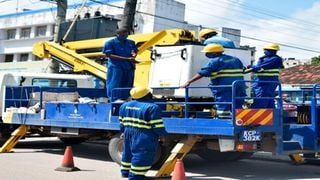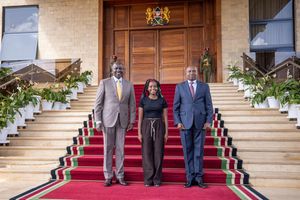
Kenya Power Company employees carry out repairs to a transformer on Haile Selassie Road Mombasa in this photo taken on December 5, 2020.
| Kevin Odit | Nation Media GroupCompanies
Premium
Cash crunch looms at Kenya Power after price cuts
What you need to know:
- Firm’s managers are keen to avoid expressing displeasure publicly over the new lower tariffs.
- Privately, the company feels it is being forced to single-handedly shoulder the burden of reducing electricity prices.
Cash-strapped utility firm Kenya Power Company is set for tougher times after the government significantly slashed electricity prices, in a move that is likely to return the firm into loss-making territory.
The Energy and Petroleum Regulatory Authority (Epra) last week reduced the energy charge for domestic lifeline consumers by Sh2.3 per unit to Sh7.7, down from the previous Sh10 adopted in November 2018.
Meanwhile, domestic consumers whose monthly consumption exceeds 100kWh but is below 15,000kWh will now pay Sh12.6 per unit, down from Sh15.8, a 20 per cent reduction.
But the firm’s managers are keen to avoid expressing displeasure publicly over the new lower tariffs, so as not to be seen standing in the way of President Uhuru Kenyatta’s efforts to lower the costs of electricity.
Privately, however, the company feels it is being forced to single-handedly shoulder the burden of reducing electricity prices despite being only an implementer of questionable government policy decisions.
These include signing on independent power producers (IPPs) without proper demand forecasting to economically justify the investment.
Most of the contracts run for an average of 20 years.
The company only bounced back from a Sh939 million net loss in the 2019/20 financial year to post a Sh1.49 billion after-tax profit for the year to June, boosted by higher earnings from electricity sales.
Selling at a loss
The lower tariffs come even as the firm buys power from private producers at a higher price than it sells it for, a situation that is set to worsen.
Auditor-General Nancy Gathungu’s report on Kenya Power for the year to June shows that the firm buys 70 per cent of its electricity (from KenGen) at about Sh5.3 per kilowatt hour, well below its selling price.
But Ms Gathungu noted that the company buys 30 per cent of its electricity - from IPPs - at an average of Sh15.3 per unit and sells it at an average of Sh15.6 per unit, which means it is selling at a loss.
“The company, therefore, entered into very expensive contracts with IPPs and was in some instances selling power below the cost price,” said Ms Gathungu.
However, the government is betting on convincing IPPs to lower their prices in negotiations that are expected to be completed before the end of March.
Failed bids for higher tariffs
The company has been fighting for years to increase its electricity prices by up to 20 per cent, citing rising operational costs that needed a corresponding increase in revenues.
Last year, Kenya Power called for an expert to help it craft a compelling tariff to be submitted to Epra.
“Whereas the company needs sufficient revenues for sustenance of its services, the power pricing in Kenya is regulated by the government,” Kenya Power told bidders in the Details of Service (DoS) document accompanying the tender.
“A key challenge over the last three years has been either delays in the review and/partial approval of the required revenues.
“The last tariff granted in 2018 was delayed for two years, a period within which the company could not recover return on investment (nor) was it compensated for incremental operating expenditure. The latest tariff application has so far been delayed for close to two years impacting negatively on the company’s financial performance.”
Insolvent
The company is insolvent, with liabilities of Sh116.11 billion compared with assets of just Sh49.63 billion as of June, leaving it in the red for the fifth year running.
The firm owes Sh6.17 billion to customers in electricity security deposits and is betting that it will not be called upon to reimburse them in the near future, despite an increasing switch to prepaid meters and to cheaper power sources, in which instances consumers claim refunds.
“Customer deposits are held as a non-current liability because the Company will continue to offer services to the customers for the foreseeable future and the customers are not expected to discontinue their use of electricity in the short run,” says the firm in its annual report.
It also has commitments of Sh11.66 billion to several ongoing projects and Sh4.76 billion to projects that are yet to start.
Kenya Power also owes Sh24.7 billion to KenGen, Sh23.19 billion to IPPs, Sh6.1 billion to suppliers, a Sh5.54 billion wheeling charge owed to Ketraco, and Sh12.09 billion to the Rural Electrification and Renewable Energy Corporation (Rerec).
Government bailouts
The National Treasury told the International Monetary Fund (IMF) that Kenya Power and troubled Kenya Airways are the two strategic state-owned entities that present the highest fiscal risk to the budget over their need for urgent multibillion-shilling bailouts to stay afloat.
For Kenya Power, lower revenues from cheaper tariffs will expose it to more financial trouble, making it ever more reliant on bailouts from state coffers.
“By December 2021, we will prepare an action plan that lays out how Kenya Power’s identified Sh110 billion liquidity gap will be covered in the medium term,” the Treasury said.
The Treasury said it will inject Sh7.5 billion into the firm in the current financial year to help it address its financial woes.
Restructuring
However, the government wants to radically reform the company in a turnaround strategy that seeks to cut corruption and wastage, and make it leaner for efficiency even with lower earnings.
Part of this plan is to boost revenues from sources such as unpaid bills from customers that have hit Sh29.66 billion, reduction of system losses and restructuring the company’s commercial debt.
The firm spends about Sh20 billion annually to service debt.
It also includes restructuring the firm and staffing levels, in a move that will trim its over 10,000 workforce.
The planned reforms also target Kenya Power’s procurement to boost stock management in a bid to lower unnecessary spending on new projects and equipment that have bled the company of billions of shillings.
Kenya Power declined to comment on whether it has the capacity to absorb the impact of lower tariffs and whether it had expressed any concerns over the impact of the tariff to Epra before submitting the tariff review application.
The Ministry of Energy and Epra could not be reached for comment on how the government plans to plug the expected revenue shortfall at Kenya Power.





